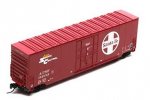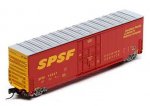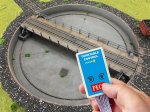タンク貨車3両セット TankTrain A/B with Intermediate Car, GATX (P-TT-L) (3)
- この商品をシェア
-
この商品について
オイルタンク貨車3両セットです。3両のタンクがホースで繋がっていて給油作業を効率化しています。
メーカ:アサーン(Athearn)
スケール:N 1/160
電源:DC
Detailed Information
GATX W/ BARBER-SCHEFFEL TRUCKS FEATURE:
New Barber-Scheffel 100-ton trucks. First time in any scale
Operated in California TankTrain service and later in New England. These cars feature an experimental self steering truck design that was intended to help aleviate rail wear.
GATX PATCHED FEATURE:
In service in California on the TankTrain. These cars were patched from the larger billboard lettering & placed into service. First time early body w/ late small lettering.
GATX WHITE FEATURE:
In service in Canada/New England/New York on a variety of railroads including the Vermont Railway & others.
N-SCALE FREIGHT CAR FEATURES:
Fully-assembled and ready-to-run out of the box
Accurately painted and printed for prototypical realism
Highly-detailed, injection-molded body
Photo etched metal walkways and end platforms
Wire safety rails and end handrails
Printed placards
Separately applied brake wheel
Screw mounted trucks
Weighted for trouble free operation
Operates on Code 50, and 80 rail
Body-mounted, McHenry operating scale knuckle couplers
Multiple road numbers
Window packaging for easy viewing, plus interior plastic blister safely holds the model for convenient storage
TANK TRAIN FEATURES:
All-new tooling first time ever in N-scale
Two GATX classes represented: 282-series and 486-series
Correct walkways, manways, and load/unload pluper series
Finely detailed walkways
Correct transfer plumbing per prototype series and end (A-end or B-end)
Full underbody plumbing and rigging
Detailed, soft vinyl transfer hoses that bend as the car negotiates curves
Cars available as end unit sets and as individual intermediate units
100-ton roller-bearing trucks with scale 36” machined metal wheels
Convenient packs of 3 makes modeling prototypical 12 unit set simple
Minimum radius: 11”
Recommended radius: 15”
282-series era: 1977 to present
486-series era: 1982 to present
PRIMED FOR GRIME MODELS FEATURE:
Duplicated look and feel of “In Service” equipment; “Tattered and Torn” just like the real thing
Faded base colors matched to the prototype
Patches applied and shaped per road number matching each corresponding side to the prototype
Perfect starting point for adding grime and rust
PROTOTYPE HISTORY:
Since the beginning of railroading in the United States, tank cars have been an essential part of the freight car fleet. From their primitive beginnings as barrels mounted to flatcars, tank cars have evolved into complex designs optimized for hauling a variety of liquids, from corn syrup to anhydrous ammonia.
While tank cars are prolific, most railroads do not own large fleets of these relatively specialized cars, preferring to make use of fleets managed by freight car companies, such as GATX. One of the larger equipment management companies, GATX can trace its history to the turn of the century, and is well-known for its large fleet of tank cars of varying designs, many of which were built in-house. One of the more distinctive designs to originate from GATX is the “TankTrain”, which made its debut in the 1970s. The TankTrain concept was a solution to the problem of long load/unload times for unit train shipments of particular commodities, such as crude oil. A typical unit train can take significant time to load or unload, with the need for workers to attach the necessary hoses and other fittings to each individual car, coupled with the necessary time to load or unload the commodity from each car. The TankTrain was designed to significantly reduce this time. TankTrain cars are interconnected with a large-diameter, flexible hose between each car, which allows the commodity to be siphoned off at a single point at the end of a set of cars while being “pushed” at the opposite end with inert nitrogen gas. Using this method, TankTrain cars can be loaded or unloaded at a rate of approximately 3,000 gallons per minute, allowing a train of 90 cars to be loaded or unloaded in under five hours. This has the obvious benefit of increased equipment utilization, as well as reduced labor costs, and shorter dwell times at terminals. Additionally, TankTrain cars were built in various sizes and designs to handle various commodities resulting in a wide variety of TankTrain cars roaming the nations’ rails. TankTrain cars are typically grouped into interconnected sets ranging from two to thirteen cars, the set size varying upon the car types, commodity, and shipper being served. One of the commodities routinely handled by TankTrain cars is crude oil, whose viscous nature, and tendency to be shipped in unit train quantities, lends itself well to the TankTrain concept. The most well-known operation using TankTrain equipment was Southern Pacific railroad’s operation of these cars, on behalf of Shell Oil Company, from a loading facility in Bakersfield, California, to a refinery in Carson, California. This operation began in the early 1980s, and proved to be highly succcesful for Shell, allowing them economical transport of Kern County crude oil to their refinery. Two trainsets were operated, allowing a continuous load/empty cycle to operate between the loadout and the refinery. These trains were comprised of insulated cars with a 23k nominal capacity, grouped into sets of 12-13 cars, with a full train being around 75-78 cars (more or less, depending upon cars that may have been cut out of the individual sets for maintenance). This train proved to be a fairly high-priority operation on the Southern Pacific, mainly stemming from the need to make sure the loaded trains arrived at the refinery on time, in order to prevent production disruptions, as well as to make sure the warmed crude oil (heated as a result of the initial extraction process) does not cool and thicken inside of the car, which would slow down the unloading process. These new Athearn N-scale models represent 23K-capacity GATX TankTrain cars from the 486-number series (built in 1977), and 282-series (built in 1982). Based upon GATX diagrams, as well as photos and field measurements taken from prototype TankTrain cars at GATX’s West Colton repair facility, these new N-scale models faithfully replicate the prototype differences between the two different series’, including variations on the tank saddles, walkways, manways, brake rigging, and transfer piping. While these cars are most closely associated with Southern Pacific, TankTrain sets comprised of these cars have been, and can be seen in operation across the country. Grand Trunk Western, for example, operated TankTrain cars from the 486-series in the Great Lakes region, hauling fuel oil, in the late 1970s. And despite construction of a pipeline that eliminated the need for Southern Pacific’s original routing of TankTrain equipment, a new TankTrain, operated by Southern Pacific successor Union Pacific along the former SP “Coast Line”, operates to this day with many of the same cars, from a loading facility in San Ardo, California, to a refinery in Carson, California.
Specifications
PROTOTYPE MANUFACTURER: General American Tank Car
COUPLER STYLE: McHenry Scale Knuckle
ERA: 1970+
Minimum Age Recommendation: 14 years
Is Assembly Required: No
N TankTrain A/B & Intermediate Car,GATX/P-TT-L (3)
- トップ
- アサーン Athearn
- N 貨車
- トップ
- 当店在庫あり
- アサーン Athearn
- N 貨車
お客様レビュー
全てのレビュー(0件)を見る »
商品レビューを書く









